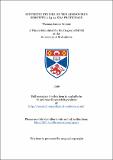Synthetic studies on the adenovirus serotype 2 L3 23 kDa proteinase
Abstract
This Thesis details research undertaken on the continuing project investigating the novel catalytic mechanism of the adenovirus serotype 2 L3 23 kDa proteinase. The proteinase is a virally encoded endopeptidase which is essential for the successful replication, maturation and spread of infectious virus particles. Three tetrapeptide esters were synthesised and tested as potential inhibitors. These tetrapeptides were based on the N-terminal minimum substrate specificity requirement established by Kemp et al. and are of the form; M(L)XGX?G or M(L)XGG?X. From these motifs it is clear that there is a very strict requirement at P2 for glycine. It is proposed that this requirement is, at least in part, steric and the three tetrapeptides synthesised and tested vary the residue at P2 in order to establish if this is the case. The three tetrapeptides are; Cbz-(25)-Leu-(25)-Ala-Gly-Gly-OPri (9), Cbz-(25)-Leu-(25)-Ala-(25)-Ala-Gly-OPri(10), Cbz-(25)-Leu-(25')-Ala-(2R)-Ala-Gly-OPri (11). Leucine was chosen over methionine for simplification of synthesis and the isopropyl ester was chosen partly for ease of synthesis and partly to complete a series of "wild-type" tetrapeptide esters which are turned over as substrates. We show that (9) does not inhibit the proteinase, that (10) inhibits by 37.41% at high concentrations and that (11) inhibits by 14.64% at the same high concentrations. The estimated Ki's for (10) and (11) are 2.1 mM and 5.3 mM respectively, neither are potent inhibitors.
Type
Thesis, MPhil Master of Philosophy
Collections
Items in the St Andrews Research Repository are protected by copyright, with all rights reserved, unless otherwise indicated.

